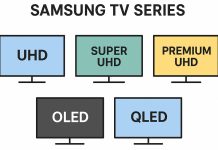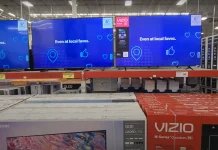OLED TVs first entered the consumer market in 2016 and have since established a strong presence in the television industry. By 2021, many companies had joined the OLED TV segment, although the core OLED technology itself has been around for much longer. LG was the pioneer in developing large-format OLED panels and continues to lead the market to this day.
Samsung entered the OLED display market in 2023 with its own QD-OLED technology. However, the company’s production capacity has so far been limited, and it does not manufacture OLED panels in all sizes. As a result, some Samsung OLED TVs are equipped with panels produced by LG.
OLED panel manufacturers: OLED makers
To begin with, you should understand that LG is the only OLED panel maker. Almost all world brands are using panels made by LG, so no matter what maker’s TV you would choose, you would get an OLED panel made by LG. There are also Chinese companies that are trying to make OLED panels, but LG is the only company that offers big OLED panels.
Also note, that almost all OLED TVs are 55 and 65 inches, that’s most popular screen size in the US.
The Evolution of OLED TVs: 2016–2025
2016: The Dawn of the OLED Era
OLED TVs became available to the mass market in 2016. LG was the clear market leader, being the only manufacturer of large OLED panels and offering several models under its own brand. Other companies, such as Sony and Panasonic, began manufacturing OLED TVs around the same time, but purchased panels from LG Display. OLED technology was considered a superior alternative to LCD/LED TVs, offering perfect black levels, high contrast, and excellent viewing angles.
In 2016, OLED TVs were expensive and mostly limited to 55- and 65-inch models. They were a novelty and targeted high-income users willing to spend several thousand dollars on a TV.
2017–2018: Wider adoption and brand expansion
By 2017 and 2018, more manufacturers had entered the OLED market, including Philips (in Europe), Loewe (Germany), and Bang & Olufsen, in addition to Sony and Panasonic.
LG improved its lineup with the B7, C7, E7, and W7 models.
2019: OLED consolidation
In 2019, OLED became an established high-end category. LG’s lineup included models such as the C9 and E9, which were highly praised for their image quality and HDMI 2.1 support. Sony released the A9G, and Panasonic continued to release models such as the GZ2000, offering superior color calibration and sound.
Philips introduced models such as the OLED804 and OLED934 in Europe, combining OLED technology with Ambilight and Android TV. Brands began to differentiate themselves more in terms of image processing, sound quality, and Smart TV software, while panel specifications remained relatively similar due to LG’s dominance in panel supply.
2020: OLED TVs
By 2020, OLED TVs had faster processors, improved AI-based image processing, and enhanced gaming features. This was due to the start of production of processors specifically for TVs, with most image enhancement programs built into the processor’s memory, which significantly sped up the TV’s performance.
Budget brands such as Hisense and Vizio announced their first OLED models. Vizio OLED TVs entered the US market with lower prices to attract buyers, but overall the experience was unsuccessful, as users noted that LG TVs were faster and better.
Loewe went bankrupt in 2019, ceasing OLED production. However, the brand was later acquired with plans to relaunch it.
2021: OLED becomes the mainstream premium class
LG introduced the new OLED Evo panel, which provides improved brightness by changing the panel structure. Micro mirrors were installed next to the pixels to redirect light to the outside of the panel, preventing it from being lost inside the panel.
2022-2023: QD-OLED
In 2022, OLED TV sizes became more diverse, with LG introducing models with 42-inch and 97-inch screens. The company continued to promote OLED Evo technology in the C2 and G2 models, providing better brightness and efficiency. OLED TVs became more suitable for gaming thanks to a 120Hz refresh rate, VRR (variable refresh rate), and HDMI 2.1 in most models.
Samsung officially released its own OLED TVs with QD-OLED (Quantum Dot OLED) technology. The S95B became Samsung’s first widely available OLED TV, offering OLED but with slightly different technology than LG’s traditional WOLED panels. Samsung has gone down the path of producing RGB OLED panels, unlike LG, which produces WRGB panels.
2024-2025: Stability
Despite marketing gimmicks such as new generations of processors, OLED TVs have remained virtually unchanged, and many small companies have abandoned the production of OLED TVs. Although there are quite a few OLED TV brands, they are mostly old brands and Chinese companies.






OLED TV from Philips with 1 L.. please is oké. In 2019 and 2020 Philips sold 4 different Models succesfull in 700 and the 800 range.